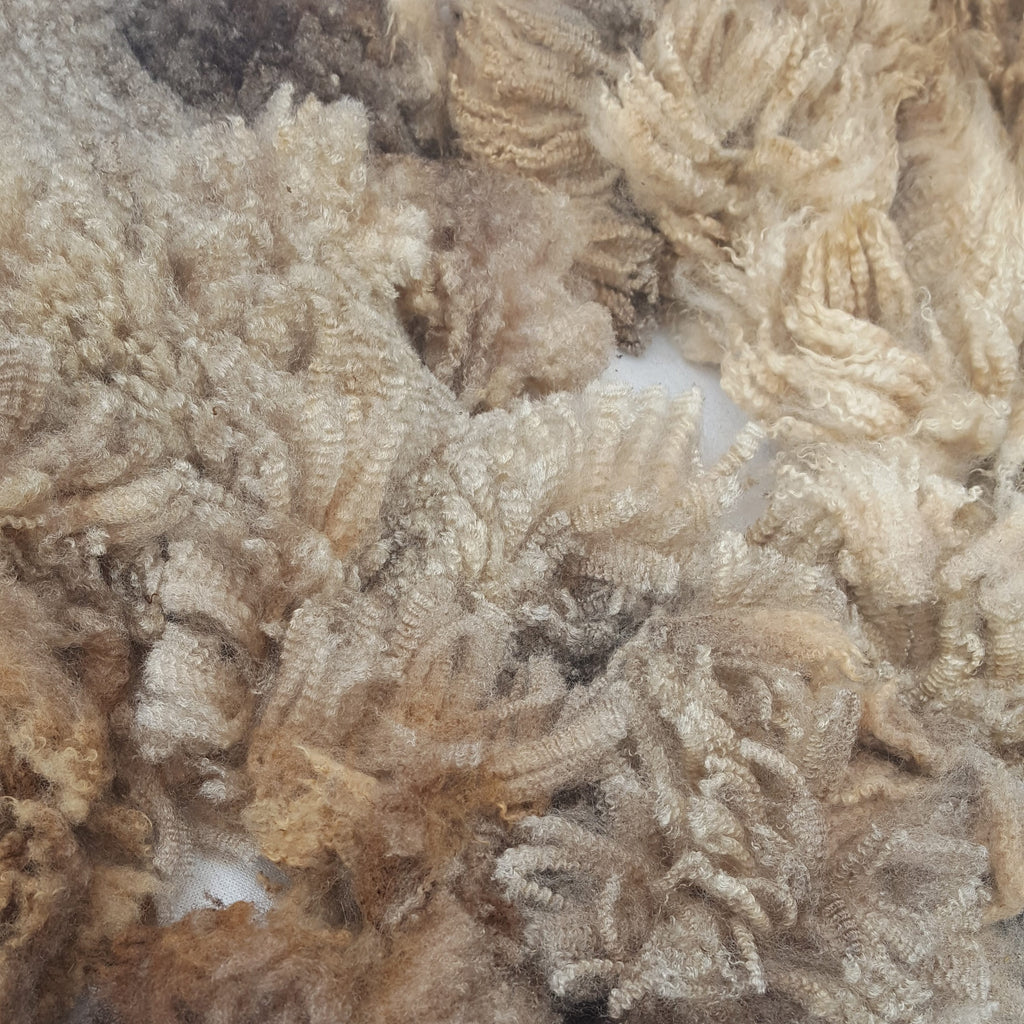
Some days--like today, when I have so many things on my to-do list that I can't decide where to start--fleece washing is just the mental vacation I need. Sure, it's messy and requires some heavy lifting, but at least I don't have to make decisions. My neighbor had her sheep sheared yesterday, and I was eager to see what her new Gotland x Border Leicester lambs had going on for themselves. Just look how sparkly and shiny she is!
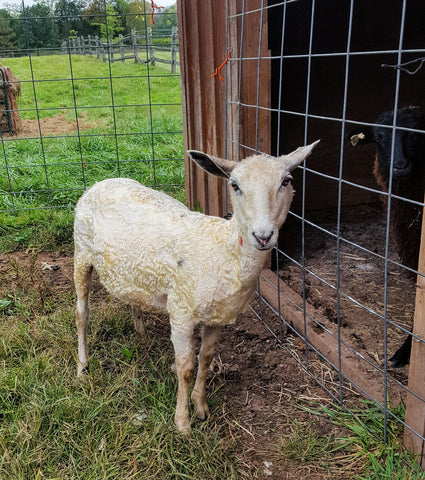
Washing a fleece successfully (and enjoying the process) really comes down to having a workable setup. In my dreams, we all have a fleece-washing rig like this one at Battenkill Fiber Mill, in Greenwich, NY. Endless hot water, drains, roomy crab baskets, and oh yes, an electric basket lifter.
But in reality, all we really need to wash fleeces is hot water and somewhere to dump the dirty water. Can you wash fleeces in a top-load washing machine, or in the bathtub? Well, I have friends who do, and I've never heard of anyone having a problem. I've heard warnings against it, but I haven't seen conclusive data. What I do know is that lanolin hardens to a sticky wax, and I also know that if my pipes become clogged because of my indoor fleece-washing activities, I would have to become way more familiar with my septic system than I ever want to be. So I choose hauling water and dumping outside, over tangling with my septic system.
When I washed fleeces in the barn, I had to carry the dirty water through the studio, and walk through the greenhouse and garden to dump the dirty water in the driveway. Having the hot water and dumping area within a few steps of one another is a new luxury for me. We put in this new door in the kitchen, and since it's right between the faucet and stove, it makes a perfect "work triangle" for washing fleeces. My washtub, soap, and fleece are set up on the deck just outside the door.
The first step is skirting the raw fleece, to remove the short second cuts, poopy bits, and as much of the veg matter as possible. When it comes to veg matter, everyone has their own personal threshold. I don't mind big things like hay, sticks, or seedheads. As long as you pull on the stem, the seedheads come right out without shattering.

But the dealkiller for me is what I call "veg shrapnel."
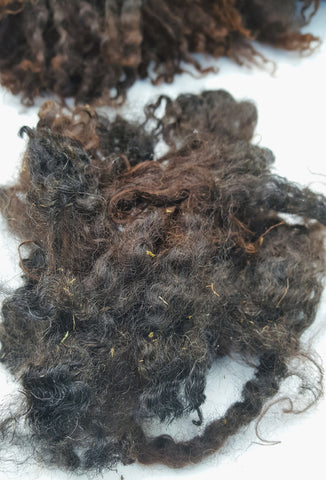
In my experience, little veg bits like these seem to come out only to get stuck in the clean fleece. When it's all washed, you can tease some of it out, but whatever you don't get out will just get carded and then spun into your yarn. And then eventually knit into your sweater. Some veg matter in minimally-processed yarn is to be expected; the alternative is to dissolve every speck of veg matter with sulfuric acid, as is done in commercial mills.
Poopy bits, believe it or not, are easier to deal with. Toss the poop, and toss the really mucky locks, especially if they're short or matted, like the clump to the right.

The clump in the center will wash out, but know that it might be the cause for needing to do that third (or fourth) hot wash.
Hopefully the majority of your fleece will look like this:

Once the fleece is skirted, I put it in a mesh laundry bag and soak it in cold water.The soak can last between a few hours to overnight. It won't do anything for the lanolin, but it'll start softening some of the poop and mud.
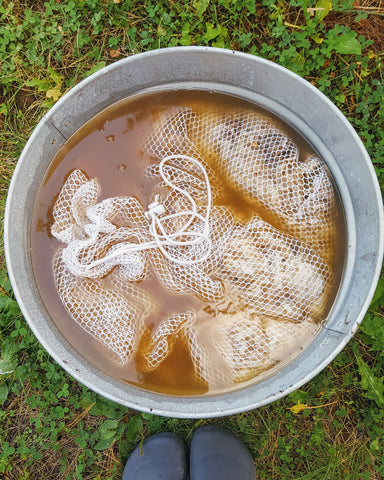
When it's time to really wash the fleece, I fill my big stockpot and heat it on the stove until it's about to start simmering. I dump that into the washtub, then fill the pot again with hot water from the faucet. The water from my faucet doesn't get hot enough to melt lanolin (there's a range of recommended washing temperatures; I've learned the hard way that my tap water alone isn't hot enough). Besides, it cools as I'm filling the pot the second time.
For soap, I've used dish detergent, Orvus paste, and I'm currently using Unicorn Power Scour. I found dish detergent to be too sudsy, Orvus paste melted the skin off my hands (I have a sensitivity to sodium lauryl sulfate), and so far, I have no complaints about Power Scour. I even like the way it smells: not perfumy--it just smells like a clean sheep.
I stuck a pump nozzle into my bottle, and it works ok. Maybe one day, I'll even trim the straw so that I can actually screw it closed. I use 2 squirts for my washtub, and swirl gently so I don't get bubbles.

The absolute hardest part of washing a fleece? NOT agitating it. It's like trying to resist the urge to scratch a poison ivy rash. We all know that the way to get anything really clean is to scrub, right? Yeah, no. Not fleece. It's best to walk away...although I've never been able to resist sneaking in a few plunges (pushing straight down is not agitating, I swear!).
It's important to not let this water cool. I set a timer for 20 minutes so I don't forget. If the water cools, the lanolin that melted off the fleece will become redeposited and nothing on god's green earth will be able to dislodge it again.*
While it's soaking, I refill my stockpot and put it back on the stove. After about 20 minutes, I fish out the laundry bag and drape it over a fence to drip, and squeeze out the water. I rinse out the tub, and do it all over again. And once more from the top.
To rinse, I fill the tub with warm water, and soak for about 30 minutes. Fish out, drape, squeeze, repeat. By now, all the lanolin has been melted off the fleece, and dumped out. So for the second warm rinse, I let the fleece soak until the water cools. When the water is cool, I rinse in cold water until the water is mostly clear. After the third or fourth cold rinse, I call it a day. Most of the fleece should look very clean, but if the water still looks murky, it'll be because there are a few stubborn dingleberries, and it's not worth rinsing the entire fleece again and again.

I lay out the fleece on the potting table in the greenhouse, and wait impatiently for it to dry. Tomorrow, I'm going to dye some of these white locks to bring to the Indie Untangled Rhinebeck Trunk Show next month.
*I once heard a tale about a woman who succeeded in fixing this mistake. She brought a pot of water to boil, and dipped the fleece lock by lock, changing the water every few locks. If anyone feels compelled to try this, please let me know if it works!
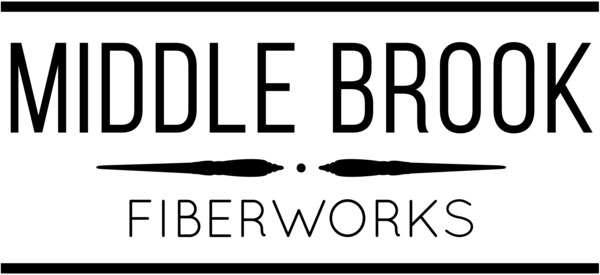


Comments on post (1)
Polly says:
Hi, I know this is old but I’ll try asking anyway. I am a city girl who was able to aquire a sheep’s fleece. ( insanely difficult to buy just 1 fleece to experiment with where I’m from) I’ve read many instructions on how to scour the fleece or how to extract the lanolin but not a good way to obtain a bit of usable lanolin while still ending up with some spinnable wool. With your experience, would it make sense to soak the fleece over night in cold water to loosen the dirt, then maybe do a cold water rinse to get that first dirt out. Then doing a couple of hot water soaks without soap to melt the lanolin and keeping that water to boil down the lanolin. Then maybe one last hot soak with soap and then a couple hot rinse soaks. Did any of this make sense? Also is it OK to put wool that has been in cold water directly into the hot water or do I have to let it dry first? I know your not supposed to put hot wool in cold water but can’t find any mention of the cold wool into the hot. Have I confused you enough? Hopefully someday you will see this and give me some answer. Thank you!
Leave a comment